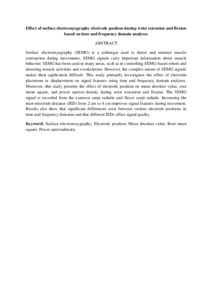Citation
Ghapanchizadeh, Hossein and Ahmad, Siti Anom and Ishak, Asnor Juraiza
(2016)
Effect of surface electromyography electrode position during wrist extension and flexion based on time and frequency domain analyses.
International Journal of Control Theory and Applications, 9 (5).
pp. 559-566.
ISSN 0974-5572
Abstract
Surface electromyography (SEMG) is a technique used to detect and monitor muscle contraction during movements. SEMG signals carry important information about muscle behavior. SEMG has been used in many areas, such as in controlling SEMG-based robots and detecting muscle activities and exoskeletons. However, the complex nature of SEMG signals makes their application difficult. This study primarily investigates the effect of electrode placement or displacement on signal features using time and frequency domain analyses. Moreover, this study presents the effect of electrode position on mean absolute value, root mean square, and power spectra density during wrist extension and flexion. The SEMG signal is recorded from the extensor carpi radialis and flexor carpi radialis. Increasing the inter-electrode distance (IED) from 2 cm to 4 cm improves signal features during movement. Results also show that significant differences exist between various electrode positions in time and frequency domains and that different IEDs affect signal quality.
Download File
![[img]](http://psasir.upm.edu.my/54056/1.hassmallThumbnailVersion/Effect%20of%20surface%20electromyography%20electrode%20position%20during%20wrist%20extension%20and%20flexion%20based%20on%20time%20and%20frequency%20domain%20analyses.pdf)  Preview |
|
Text
Effect of surface electromyography electrode position during wrist extension and flexion based on time and frequency domain analyses.pdf
Download (6kB)
| Preview
|
|
Additional Metadata
Actions (login required)
 |
View Item |

